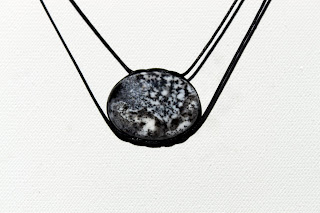

Tibetan turquoise rarely comes in a pure blue colour as most pieces contain matrix, veins which may be brown (limonite), dark-grey (sandstone), or black (jasper); the spider-web matrix of the Tibetan material has a design unequaled by turquoise from any other part of the world.
To call a turquoise a stone will offend a Tibetan who will exclaim, "this is a turquoise and not a stone," looking upon it as a thing distinct in itself.
Turquoise is an aluminium phosphate coloured by copper (blue) and iron (green), and until very recently was considered amorphous (not having any internal arrangement of atoms).
A source of inspiration to all Tibetans, there are no two turquoise gems alike, and when observed sub-atomically it is found that it can no longer be regarded as an inert mass of matter. Each gem is a vibrating essence of atoms, a phenomenon distinct in itself!



 The turquoise cabochons often have very obscure shapes, making them great to set in our design. We can have it off-set and askew, making the design even more stunning!
The turquoise cabochons often have very obscure shapes, making them great to set in our design. We can have it off-set and askew, making the design even more stunning!







